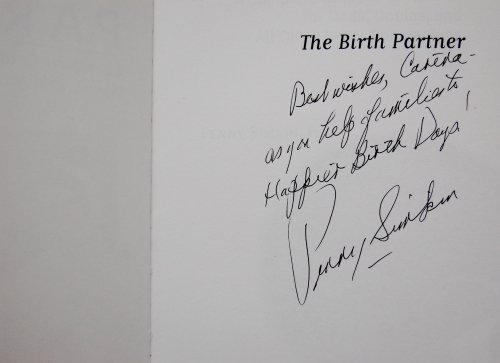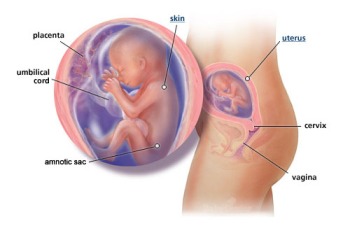I recently had the privilege of attending a workshop by the legendary Penny Simkin on normal birth, traumatic birth, 3rd and 4th stages of labor, rebozo techniques, and advanced comfort measures. If you’re not already overcome with envy, you must not know who Penny is. In short, she is a physical therapist, childbirth educator, doula, one of the founders of DONA, has written some of the best birth books out there (The Birth Partner and Pregnancy, Childbirth and The Newborn are my favorites), and it is because of her that we have squat bars and birth balls in hospitals (she invented them). The woman has a seriously impressive resume. If it wasn’t for Penny Simkin, doulas as we know them may never exist, and they certainly wouldn’t be as common as they are now. She is the mother doula and is by far one of the best. Its incredible to see her in action supporting a woman and I am so grateful that we have the ability to observe great doulas doing what they do best. Her motto is “How will she remember it?”. She, being the mother, is at the center of a doula’s work and Penny promotes and executes this model of care flawlessly. She is equal parts sweet, motherly, warm, intuitive, insightful, funny, honest and feisty. It is such a gem to see a nearly 70 year old woman (although you wouldn’t guess it by the joy and cheer spilling out of her) who has spent the last 44 years in the face of animosity to facilitate better experiences for women, still has such a fire burning within her after all this time and hard work.
The workshop was hosted at BINI Birth (my doula home!) by my trainer Ana Paula Markel. I love when we have big names come to BINI because the energy buzzing is electrifying and SO contagious. We are like fan girls eagerly awaiting (insert legendary birth professional’s name here) arrival, we constantly check in on Facebook and Twitter to see if they have landed at the airport yet, what amazing dish Ana Paula made them for dinner, funny things they’ve said, if they’re almost at BINI,… its like expecting The Beatles to arrive.
Just like with Ina May Gaskin and Phyllis Klaus, the morning of March 31st had the same wild buzzing energy. If you thought any of the 60+ doulas, RN’s, and midwives who attended were able to sleep a wink the night before, you would probably be wrong. My wake up time couldn’t come soon enough and I, like the others, spent the day both in awe and furiously scribbling down every inspirational word that came out of Penny’s mouth (that’s just about every word, by the way). She granted me permission to share her wisdom, which I think is so important because while she has touched thousands upon thousands of people with her findings and insights, there can always be more minds opened and lives touched.
Here are some of Penny’s insights and knowledge:
ON NORMAL BIRTH
Before we can talk about what normal birth looks like, we must answer the question of normal vs. natural. Is normal birth and natural birth the same thing?
Definition of Natural: existing or derived from nature, not made, caused by, processed by, or derived from man.
Definition of Normal: Conforming to a standard; usual, average, typical or expected.
- Normal Birth never changes physiologically, however statistical norms change constantly and are influenced by trends and values. It also varies geographically.
- The WHO defines normal birth as being low risk from start to finish with spontaneous onset at 37-42 weeks. UK Midwife Debby Gould adds to this definition that normal labor and birth involves strenuous physical work by mother, includes movement seeking comfort and progress, and movement by fetus through birth canal.
- The outcome of a normal birth is a healthy motherbaby who are ready to adjust to their new roles, with the woman feeling empowered, with a sense of achievement for productive work she has done.
The doulas role in preserving normal birth is to:
-Simply being present with her
-Model confidence in process with no sense of urgency or need to control it
-Watch before acting
-Have patience and confidence “babies come out’
-Help her accept labor pattern “labor unfolds at its own pace”
Doulas Motto: “If it ain’t broke, don’t fix it”
Physiologic norm is the standard against which all care should be measured: How and how much is normal process altered? What are the outcomes?
ON INTERVENTIONS AND OUTCOMES
What are the 2 main approaches to labor today?
Psycho-physiologic (mind/body) management:
-designed to maintain and enhance the mother’s resources for giving birth
-woman’s state of mind influences labor
-active role of woman improves outcome
Industrialized:
-designed to replace or alter the body’s own resources
-more control over process
-based on beliefs that normal process is unsafe/unreliable and outcomes are improved with intervention
-requires less skill for difficult birth (example: quick c-section for breech baby instead of turning )
-inductions/cesareans are no worse for motherbaby and may be better than normal birth
-original intention was to improve outcomes with interventions that have now become routine
-we are paying the price in prematurity and perinatal mortality/morbidity
How does place of birth affect labor?
A “safe” undisturbed environment support spontaneous behavior and facilitates secretion of Oxytocin (by not feeling disturbed, watched, connected).
Strange environments (unfamiliar, noisy, bright, and intrusive) interfere with Oxytocin production and create an adverse fetal response.
How does the way labor begins affect labor?
Spontaneous labor ensures fetal readiness since it is the baby who starts labor when he is ready for extra-uterine life.
Induced labor increases late term prematurity and incidences of postpartum hemorrhage, fetal distress, c-sections, instrumental deliveries, NICU admissions, separation and increases labor time. 80% of inductions are done for non-medical reasons.
How does IV Hydration affect labor?
- Creates discomfort and inconvenience (wires and restriction of movement)
- Causes fluid overload at an average of 7 gallons/12 hours. This leads to swelling of feet and hands (more discomfort) and Hyponatremia (loss of sodium in blood)
- Mother feels deprived of basic comfort. Drinking her liquid of choice enhances sense of normalcy and in most cases will provide her with adequate hydration
- Body prepares for labor by increasing fluids by 40% and women tend to need less fluids in labor than they usually do.
- Too much oral fluid can lead to prolonged labor (Note to doulas: do not force fluids, only offer)
How does external fetal monitoring (EFM) affect labor?
- Restricts mother’s activity
- More c-sections for non-reassuring fetal heart rate tracings
- Differing interpretations of heart rate tracings by experts
- No improvement in fetal outcomes
- Inability of caregiver to auscultate (hearing with ears, stethoscope, fetoscope, or pinard horn). Auscultation is less disturbing to mother and has outcomes as good as EFM.
- Impact of doulas have been studied more than EFM
How does amniotic sac care affect labor?
Artificial Rupture of Membranes (AROM)
- may speed labor by 40 minutes
- May cause pre-existing fetal malposition to become persistent (fluid provides baby with space and medium in which to move and reposition)
- increases risk of infection
Spontaneous Rupture of Membranes (SROM)
- usually occurs late in 1st stage or in 2nd stage
- 75% of women’s waters break during transition, 66% break during pushing, if not before labor
- 1 in 7 break before onset of labor
How does pain medication affect labor?
- Narcotics are uneffective and unpleasant for mother but great for caregiver.
- Woman is relaxed and sleepy, not active, and her movement is restricted. This can slow and even halt labor.
- She only feels hard peak of contractions perceived as sudden unexpected pain which is quickly over. There is no chance for her to become used to the sensation as she cannot feel them build.
- Invasive and unsafe without precautions and interventions
- 7 to 8 other tubes/lines to keep epidural safe
- There is a difference between pain and suffering. If mother is coping with pain, no big deal. Mother can suffer without pain and with epidural. Suffering may increase likelihood of trauma and PTSD.
How do positions and movement affect labor?
Standard (Supine/Lithotomy) position –
- Restricts movement
- Increases risk of Dystocia and malposition
- Increases pain and discomfort
- Higher risk of maternal and fetal distress
Freedom of Movement/Choice of Position –
- Increases comfort
- Enhances maternal satisfaction
- Shorter labors in some studies
- Narrows birth canal up to 30%
- Working against gravity
- Increases assisted deliveries (forceps, vacuum, cesarean)
- Increases pelvic floor damage (tearing and episiotomy)
- Prolongs 2nd stage (pushing)
Non-Supine and Mother’s Choice

- Increases chance for spontaneous birth
- Reduces pelvic floor damage
- Increases mothers satisfaction
- More on labor positions can be read here and here
ON 3RD AND 4TH STAGE (Placenta delivery/cord cutting and first hours after birth)
Holistic definition of 3rd Stage:
- Enormous transition of fetus-to-newborn
- Baby is dried and placed skin-to-skin and all senses are involved. How does mom feel (skin and breath), sound (voice and heartbeat), smell (breath, breast), taste (sweat and colostrum), look (breast and face)?
- In a normal 3rd stage, family should be together skin-to-skin
Hormonal influences of 3rd Stage (all promote bonding):
- Prolactin (‘the altruistic hormone’) levels rise related to baby’s suckling (intensity, duration, and frequency)
- Oxytocin (‘the love hormone’) levels increase in motherbaby in first hours and remain for days, smells augment the mother and baby’s release of Oxytocin-
- Beta-endorphins (anti-pain hormone) – induces feelings of pleasure, euphoria, mutual dependency, released in response to pain, peaks at birth for motherbaby
- Catecholamines (‘the stress hormones’) are high during 2nd stage (pushing) and drops steeply after baby is born, baby produces catecholamines during birth which promotes adaptation to extra-uterine life (absorption of lung liquid, inflation of lungs, alertness, wide eyes, temperature regulation, placental blood transfusion to baby, metabolism of brown fat for warmth.
- Epidurals block Oxytocin release, Michel Odent says everything gets wiped out by epidural (hormonally), endocrine system is “pretty well blocked” by epidurals and cesareans
In human life, there is no greater transformation than what happens within the first 5 minutes after birth:
Baby absorbs/spits up lung fluid > lungs expand for air > baby takes first breaths > within 2-3 breaths circulation of entire body is re-routed to lungs > ~20 mins later saliva is produced and digestive juices begin to flow > baby searches for breast and suckles
What are the effects of suctioning?
- Bulb and deep suctioning can cause gagging, abrasions of mucus membranes and oral aversions
- Does not reduce respiratory problems or meconium aspiration in vigorous babies
- Deep suctioning can cause cardiac arrhythmia
- Vigorous newborn is able to expel fluids, mucus, and handle meconium. Self-clearing of secretions may improve early breastfeeding
Penny spoke quite a bit about the harmful effects of immediate cord clamping (routine practice in hospitals) and the benefits of delayed cord clamping. I didn’t take many notes during this time since this is a topic I am also very passionate about and wanted to really absorb everything she was saying. In lieu of notes, here is Penny’s wonderful video on the subject:
4th stage A.K.A. Family Integration Period
Mutual regulation occurs as Mother helps baby to:
- improve adaptation to life outside of the womb
- regulate temperature
- conserve energy
- adjust respiration, reduce crying
- adjust noisy behaviors
Baby also helps mother with:
- involution (uterus contracting down to pre-pregnancy size
- caring for baby with touch, nursing, and hormone production
Preserving these moments by holding space and not interfering is so vital in the beginning of a baby’s life and the bond she will share with her parents. The stronger the bond, the better, and usually all it takes is to step back, leave the room, and let the new family be (unless medical intervention is absolutely necessary). Penny talked quite a bit about traumatic birth as it is unfortunately more common than we may believe (1 in 3 to 1 in 4 women report their births as being traumatic and may of those births were considered clinically normal). There is much information to be shared on the subject and for that I will let Penny take over. Her website is a wonderful resource that includes many of her powerpoint presentations and articles she has written which you can see here.
Thank you to Penny Simkin for everything you have done for families, for sharing your wisdom so enthusiastically, and for giving me permission to share your words and findings as well. It was truly a blessed day at BINI and we hope you come back soon!











